Preparation and Performance Study of SiC-Reinforced Fe-Based Wear-Resistant Composite Grinding Media
Abstract
1. Introduction
2. Materials and Methods
2.1. Raw Materials and Abrasives
2.2. Orthogonal Experiment for the Preparation of Composite Material Grinding Media
- (1)
- A specific ratio of reduced Fe powder and SiC powder was combined. The preparation of the powder mixture involves using wet ball milling to prevent the oxidation of the Fe powder during grinding. For the grinding and mixing media, 304 stainless steel balls were used. Each milling jar contained 100 mL of anhydrous ethanol, with a grading of 10 large balls with a diameter of 20 mm and 20 small balls with a diameter of 10 mm, at a material ratio of 1:2 and a rotation speed of 200 rpm. The mixing time was set. Subsequently, the powder mixture was subjected to vacuum drying for future use.
- (2)
- Preparation of grinding media by hot pressing sintering: In this experiment, conductive hot pressing sintering methods and equipment were employed to prepare the grinding media. The powder mixture was placed in a mold and pressed into a cylinder with a diameter of approximately 20 mm and a height of 25 mm. Figure 4 is a simplified diagram of the hot-pressing sintering process. The molding pressure was set to 10 MPa. To enhance the performance of the grinding media, an orthogonal experiment was conducted with a four-factor, three-level experimental design for process research. The four factors considered in the study were the particle size of the powder mixture (grinding time), the content of the SiC, the temperature of the sintering process, and the holding time. The objective is to optimize the wear rate of the grinding media and the efficiency of grinding abrasives. Table 3 shows the design of influencing factors and levels.
2.3. Characterization of Composite
2.4. Measurement of Grinding Media Performance
- (1)
- Wear resistance measurement
- (2)
- Grinding abrasives efficiency
3. Results and Discussion
3.1. Analysis of Orthogonal Experiment Results
3.2. XRD and SEM Analysis Results
3.3. Comparative Study of Grinding Media Performance
4. Conclusions
- (1)
- An orthogonal experiment was employed to investigate the relationship between the wear rate of grinding media and the efficiency of grinding abrasives. The factors selected for exploration included the grinding time of the powder mixture, SiC content, sintering temperature, and holding time. The optimal preparation process was identified as follows: the grinding time of the powder mixture was five hours, incorporating 10 wt% SiC, sintering at 1100 °C, and a holding time of 15 min.
- (2)
- The phase changes in the sintered grinding media were analyzed using XRD technology. As the sintering temperature increased, the diffraction peak of Fe2Si appeared and intensified. By 1100 °C, the diffraction peak of FeSi also began to appear; however, these peaks were relatively weak compared to the raw materials, indicating that the reactions at these temperatures were not very intense.
- (3)
- The results of the wear rate tests on grinding media indicate that those made from SiC-reinforced Fe-based wear-resistant composite had a lower wear rate compared to those containing chromium, especially when grinding standard sand. After 1 h of grinding, the wear rate decreased by 2.9 times, and after 3 h, it decreased by 3.1 times. Although the reduction is slightly less for sandstone and iron slag, it remains significant.
Author Contributions
Funding
Institutional Review Board Statement
Informed Consent Statement
Data Availability Statement
Conflicts of Interest
References
- Tsuzuki, R.; Yuasa, E. Alloying and Amorphization Processes in the Mechanical Alloying of Al-Ni-Zr Mixed Powder by Planetary Ball Mill. J. Jpn. Soc. Powder Powder Metall. 2000, 47, 1144–1149. [Google Scholar] [CrossRef][Green Version]
- Zhu, H.; Ke, B.; Lei, L.; Feng, H.; Wan, J.; Shen, Z. Influence of Galvanic Interaction between the Iron Grinding Medium and Chalcopyrite on Collectorless Flotation Behavior of Chalcopyrite: Experimental and Density Functional Theory Study. Langmuir 2023, 40, 462–473. [Google Scholar] [CrossRef] [PubMed]
- Zhang, X.; Han, Y.; Sun, M.; Li, W.; Li, Y.; He, J. Insight into the effects of grinding media on the flotation kinetics of chalcopyrite. Adv. Powder Technol. 2022, 33, 103860. [Google Scholar] [CrossRef]
- Simba, K.P.; Moys, M.H. Effects of mixtures of grinding media of different shapes on milling kinetics. Miner. Eng. 2014, 61, 40–46. [Google Scholar] [CrossRef]
- Ipek, H. Effect of Grinding Media Shapes on Breakage Parameters. Part. Part. Syst. Charact. 2007, 24, 229–235. [Google Scholar] [CrossRef]
- Vaitekhovich, P.E.; Semenenko, D.V. Characteristic Features of the Movement of Grinding Charges in Planetary Mills with External Rolling. Chem. Pet. Eng. 2005, 41, 360–362. [Google Scholar] [CrossRef]
- Magini, M.; Iasonna, A.; Padella, F. Ball milling: An experimental support to the energy transfer evaluated by the collision model. Scr. Mater. 1996, 34, 13–19. [Google Scholar] [CrossRef]
- Radu, P.L.; Amelitta, L.; Cristian, P. Considerations Concerning the Dynamics of Vibratory Mills Used in Powders’ Mechanical Milling Process. Analele Univ. Eftimie Murgu Reşiţa Fasc. Ing. 2010, 17, 31–38. [Google Scholar]
- Kulu, P.; Hussainova, I.; Veinthal, R. Solid particle erosion of thermal sprayed coatings. Wear 2005, 258, 488–496. [Google Scholar] [CrossRef]
- Chintha, A.R.; Valtonen, K.; Kuokkala, V.T.; Kundu, S.; Peet, M.J.; Bhadeshia, H.K.D.H. Role of fracture toughness in impact-abrasion wear. Wear 2019, 428, 430–437. [Google Scholar] [CrossRef]
- Rojacz, H.; Katsich, C.; Kirchgaßner, M.; Kirchmayer, R.; Badisch, E. Impact-abrasive wear of martensitic steels and complex iron-based hardfacing alloys. Wear 2021, 492, 204183. [Google Scholar] [CrossRef]
- Varga, M.; Rojacz, H.; Winkelmann, H.; Mayer, H.; Badisch, E. Wear reducing effects and temperature dependence of tribolayer formation in harsh environment. Tribol. Int. 2013, 65, 190–199. [Google Scholar] [CrossRef]
- Nicholls, C.J.; Boswell, B.; Davies, I.J.; Islam, M.N. Review of machining metal matrix composites. Int. J. Adv. Manuf. Technol. 2016, 90, 2429–2441. [Google Scholar] [CrossRef]
- Ghasali, E.; Alizadeh, M.; Niazmand, M.; Ebadzadeh, T. Fabrication of magnesium-boron carbide metal matrix composite by powder metallurgy route: Comparison between microwave and spark plasma sintering. J. Alloys Compd. 2017, 697, 200–207. [Google Scholar] [CrossRef]
- Shirvanimoghaddam, K.; Hamim, S.U.; Karbalaei Akbari, M.; Fakhrhoseini, S.M.; Khayyam, H.; Pakseresht, A.H.; Ghasali, E.; Zabet, M.; Munir, K.S.; Jia, S.; et al. Carbon fiber reinforced metal matrix composites: Fabrication processes and properties. Compos. Part A Appl. Sci. Manuf. 2016, 92, 70–96. [Google Scholar] [CrossRef]
- Chang, R.; Zang, J.; Wang, Y.; Yu, Y.; Lu, J.; Xu, X. Comparison study of Fe-based matrix composites reinforced with Ti-coated and Mo-coated SiC particles. Mater. Chem. Phys. 2018, 204, 154–162. [Google Scholar] [CrossRef]
- Jiahao, Y.; Ruiqi, M.; Mingming, Z.; Yilian, X.; Jiahui, S.; Xiaohong, L.; Haolin, L.; Jianjun, C. Microstructure and mechanical properties of hot-pressed SiC nanofiber reinforced SiC composites. Ceram. Int. 2022, 48, 15364–15370. [Google Scholar]
- Jin, W.; Zhou, Y. Fabrication of Cu-adhered silicon carbide particles and its effect on properties of Fe-based matrix composites. Mater. Res. Express 2022, 9, 066–501. [Google Scholar] [CrossRef]
- Wenming, T.; Zhixiang, Z.; Yucheng, W.; Zhihao, J. Interface stability of the SiC particles/Fe matrix composite system. J. Wuhan Univ. Technol.-Mater. Sci. Ed. 2006, 21, 49–53. [Google Scholar] [CrossRef]
- Cui, S.; Jung, I.-H. Critical reassessment of the Fe-Si system. Calphad 2017, 56, 108–125. [Google Scholar] [CrossRef]
- Liu, Z.Y.; Xiao, B.L.; Wang, W.G.; Ma, Z.Y. Modelling of carbon nanotube dispersion and strengthening mechanisms in Al matrix composites prepared by high energy ball milling-powder metallurgy method. Compos. Part A Appl. Sci. Manuf. 2016, 94, 189–198. [Google Scholar] [CrossRef]
- Munir, K.S.; Zheng, Y.; Zhang, D.; Lin, J.; Li, Y.; Wen, C. Improving the strengthening efficiency of carbon nanotubes in titanium metal matrix composites. Mater. Sci. Eng. A 2017, 696, 10–25. [Google Scholar] [CrossRef]
- Simões, S.; Viana, F.; Reis, M.; Vieira, M. Aluminum and Nickel Matrix Composites Reinforced by CNTs: Dispersion/Mixture by Ultrasonication. Metals 2017, 7, 279. [Google Scholar] [CrossRef]
- Yu, Z.; Yang, W.; Zhou, C.; Zhang, N.; Chao, Z.; Liu, H.; Cao, Y.; Sun, Y.; Shao, P.; Wu, G. Effect of ball milling time on graphene nanosheets reinforced Al6063 composite fabricated by pressure infiltration method. Carbon 2019, 141, 25–39. [Google Scholar] [CrossRef]
- Munir, K.S.; Li, Y.; Qian, M.; Wen, C. Identifying and understanding the effect of milling energy on the synthesis of carbon nanotubes reinforced titanium metal matrix composites. Carbon 2016, 99, 384–397. [Google Scholar] [CrossRef]
- Liu, Z.Y.; Xu, S.J.; Xiao, B.L.; Xue, P.; Wang, W.G.; Ma, Z.Y. Effect of ball-milling time on mechanical properties of carbon nanotubes reinforced aluminum matrix composites. Compos. Part A Appl. Sci. Manuf. 2012, 43, 2161–2168. [Google Scholar] [CrossRef]
- Bradbury, C.R.; Gomon, J.-K.; Kollo, L.; Kwon, H.; Leparoux, M. Hardness of Multi Wall Carbon Nanotubes reinforced aluminium matrix composites. J. Alloys Compd. 2014, 585, 362–367. [Google Scholar] [CrossRef]
- Lasio, B.; Torre, F.; Orrù, R.; Cao, G.; Cabibbo, M.; Delogu, F. Fabrication of Cu-graphite metal matrix composites by ball milling and spark plasma sintering. Mater. Lett. 2018, 230, 199–202. [Google Scholar] [CrossRef]
- Chamroune, N.; Mereib, D.; Delange, F.; Caillault, N.; Lu, Y.; Grosseau-Poussard, J.-L.; Silvain, J.-F. Effect of flake powder metallurgy on thermal conductivity of graphite flakes reinforced aluminum matrix composites. J. Mater. Sci. 2018, 53, 8180–8192. [Google Scholar] [CrossRef]
- Carneiro, Í.; Viana, F.; Vieira, M.F.; Fernandes, J.V.; Simões, S. EBSD Analysis of Metal Matrix Nanocomposite Microstructure Produced by Powder Metallurgy. Nanomaterials 2019, 9, 113–125. [Google Scholar] [CrossRef]
- Li, N.Y.; Yang, C.; Li, C.J.; Guan, H.D.; Fang, D.; Tao, J.M.; Liu, Y.C.; Yi, J.H. Carbon nanotubes reinforced aluminum matrix composites with high elongation prepared by flake powder metallurgy. Diam. Relat. Mater. 2020, 107, 107–907. [Google Scholar] [CrossRef]
- Pelleg, J. Reactions in the matrix and interface of the Fe-SiC metal matrix composite system. Mater. Sci. Eng. A 1999, 269, 225–241. [Google Scholar] [CrossRef]
- Abenojar, J. Atmosphere influence in sintering process of stainless steels matrix composites reinforced with hard particles. Compos. Sci. Technol. 2003, 63, 69–79. [Google Scholar] [CrossRef]
- Kheradmand, A.B.; Fattahi, M.R.; Tayebi, M.; Hamawandi, B. Tribological Characterization of Reinforced Fe Matrix Composites with Hybrid Reinforcement of C, Cu, and SiC Particulates. Crystals 2022, 12, 598. [Google Scholar] [CrossRef]
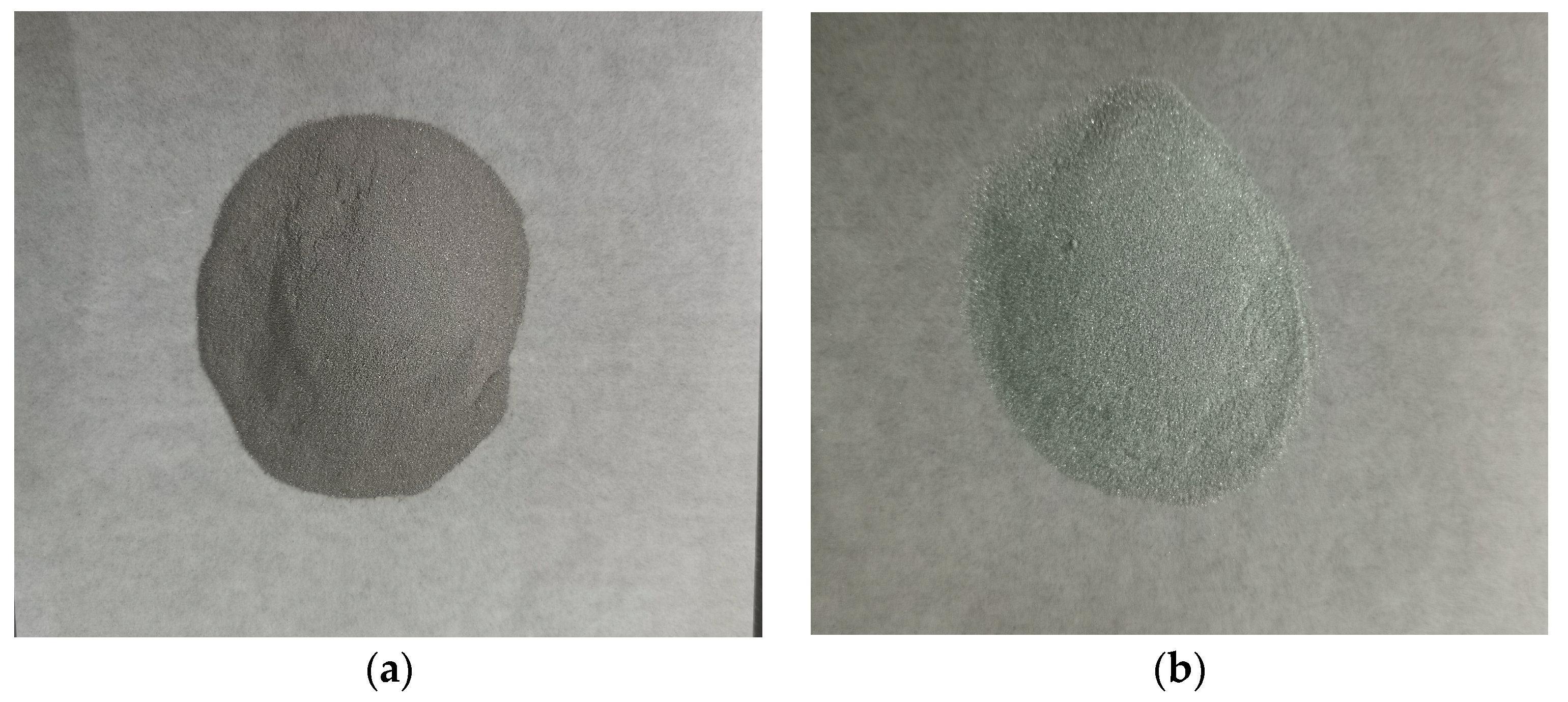
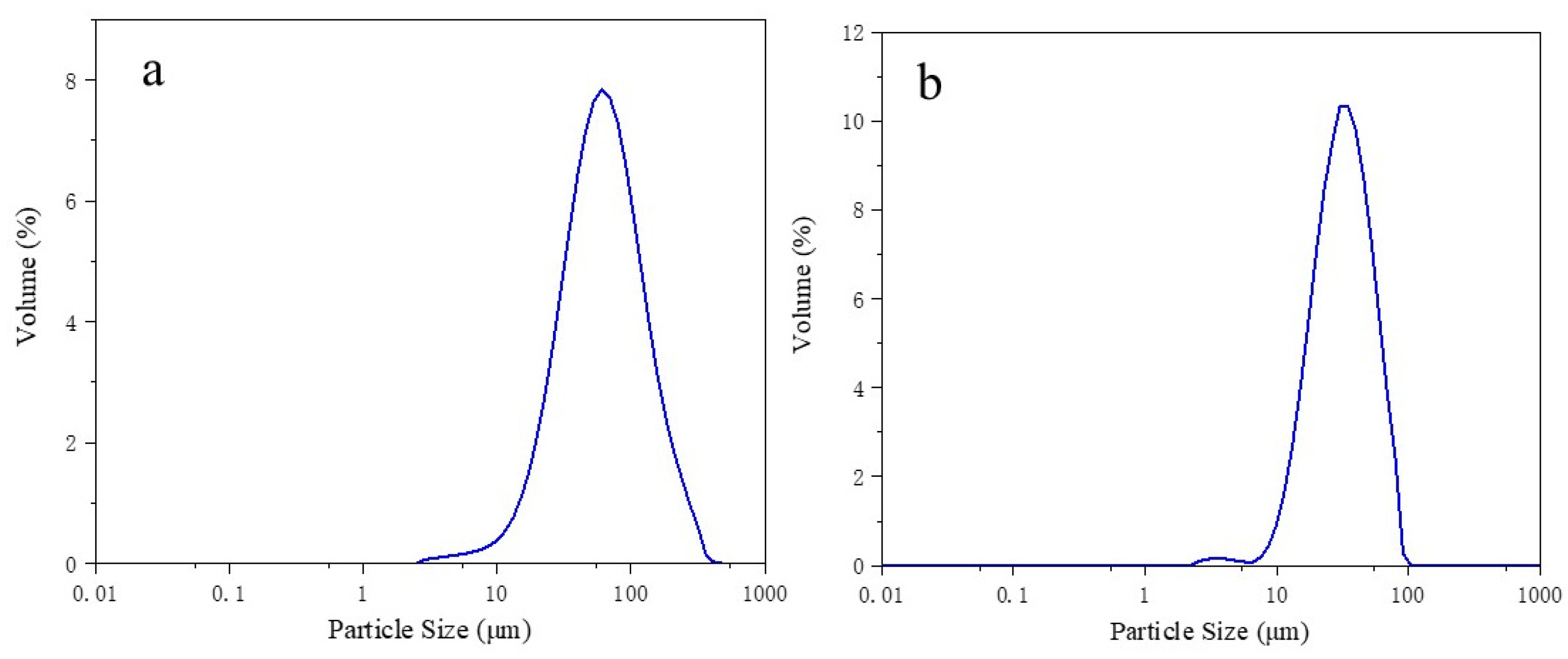



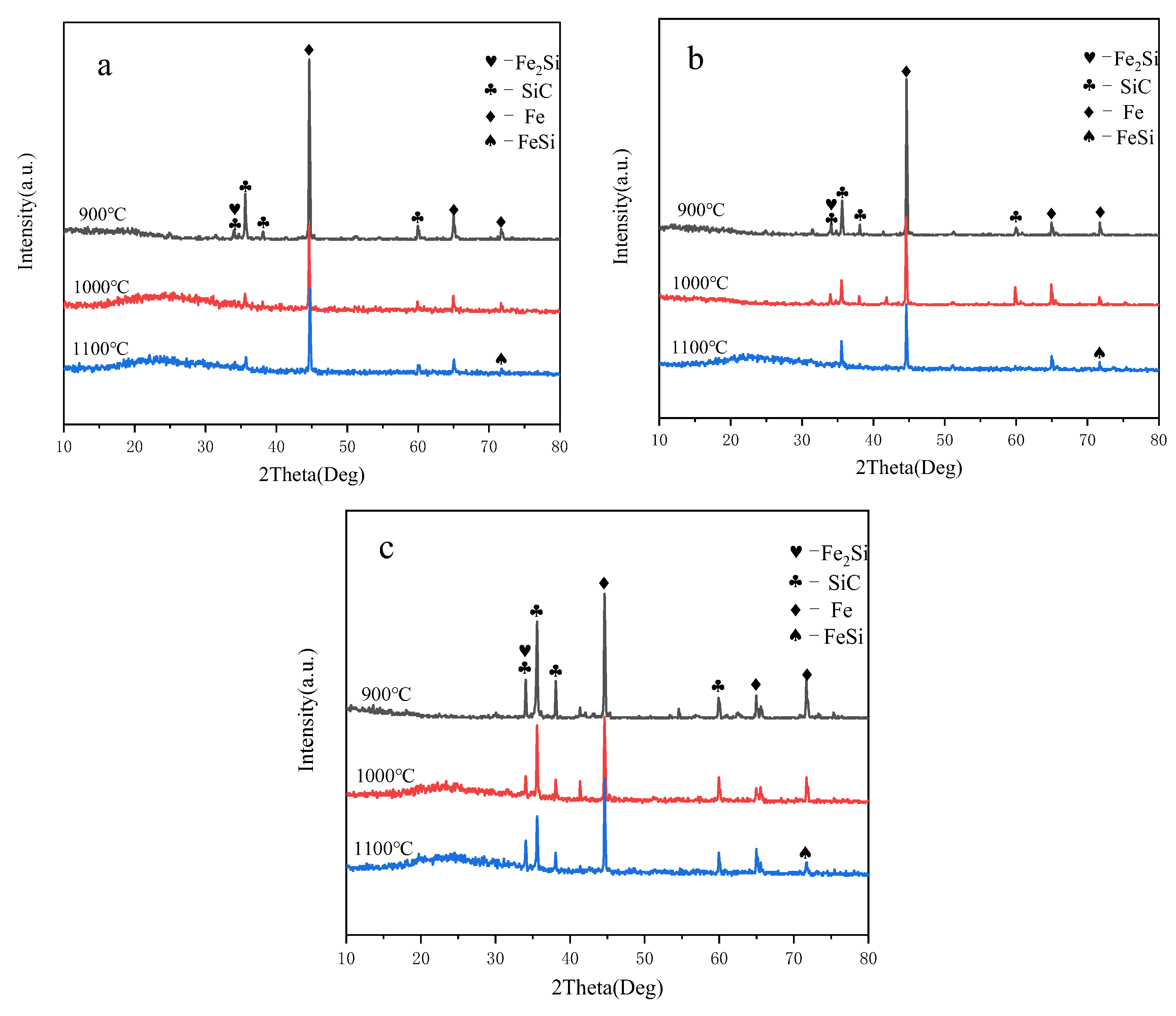
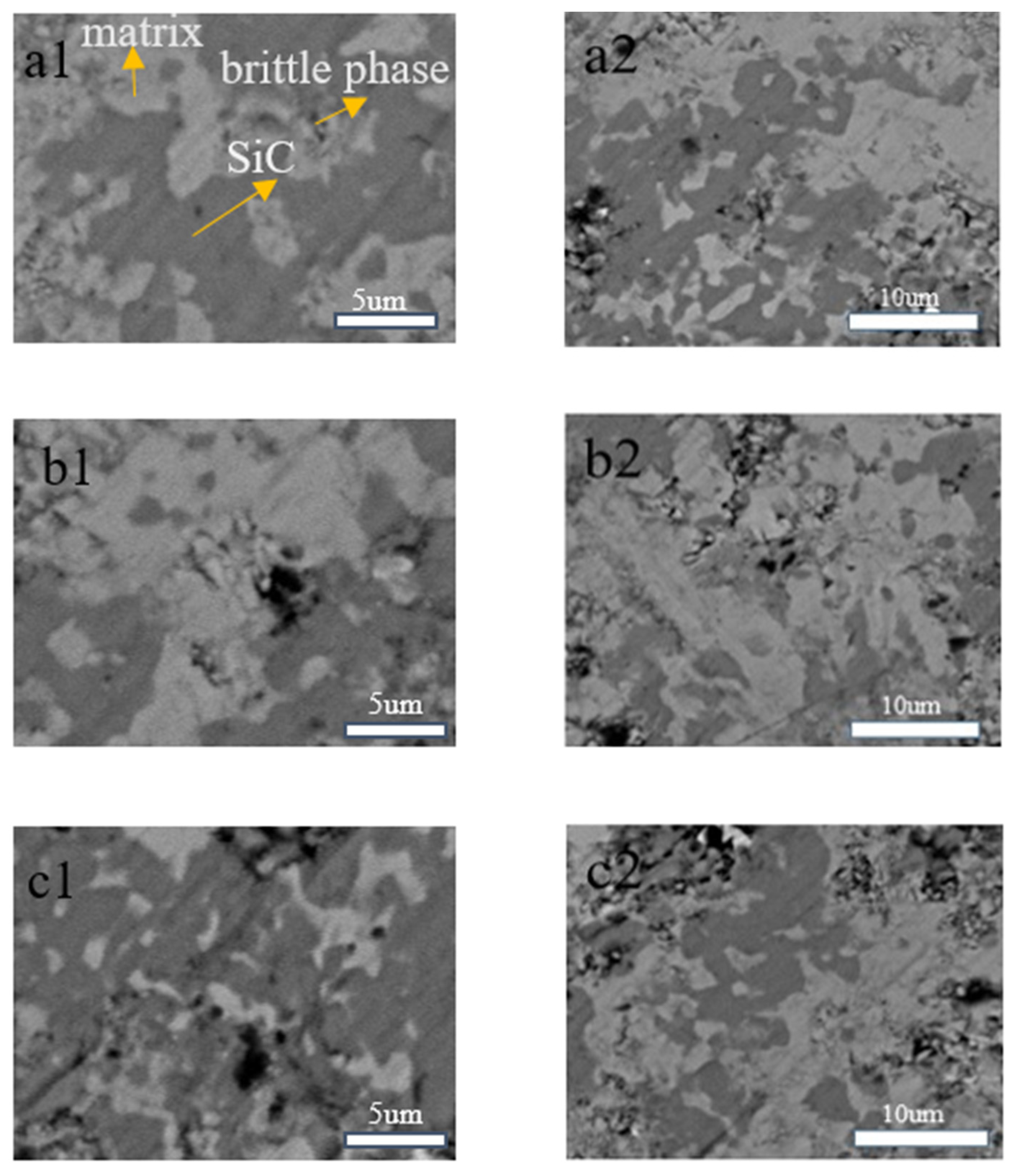
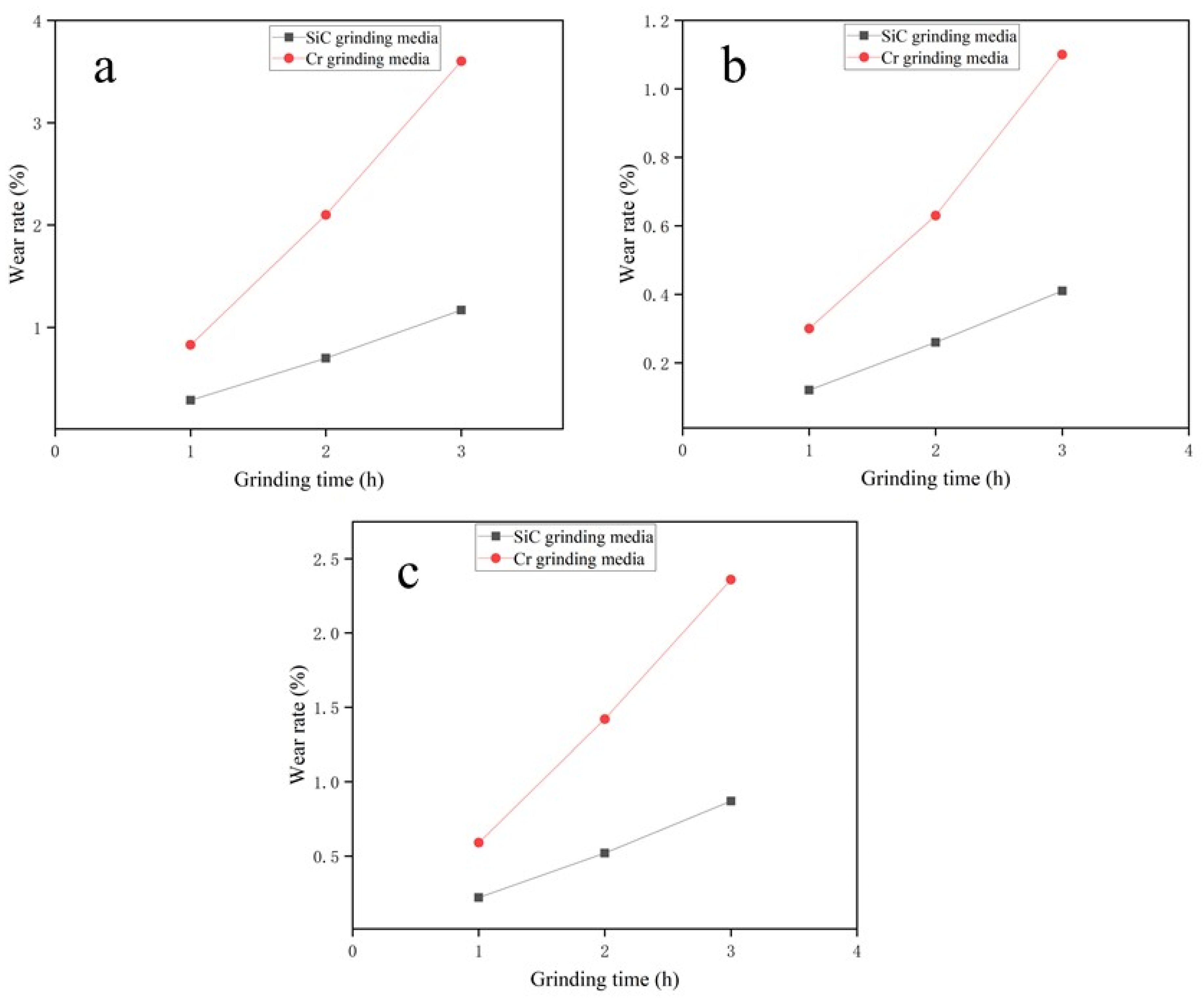

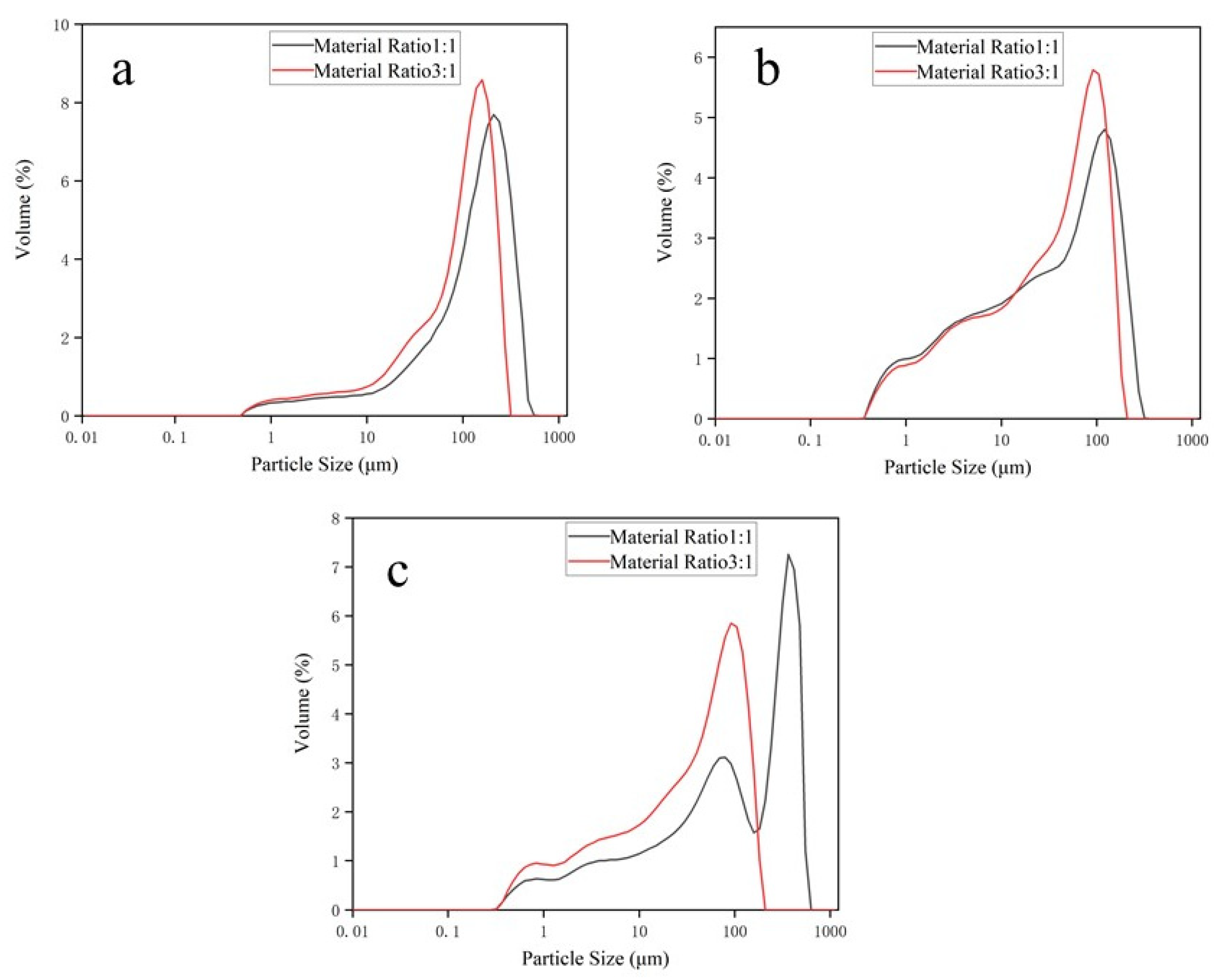
| Chemical Composition | Fe | Al | Ca | Si | Mn | Others |
|---|---|---|---|---|---|---|
| Content (%) | 98.5000 | 0.2600 | 0.1850 | 0.2560 | 0.4010 | 0.3980 |
| Chemical Composition | SiC | Ca | Ni | Fe | Al | Others |
|---|---|---|---|---|---|---|
| Content (%) | 98.8500 | 0.0965 | 0.0414 | 0.4030 | 0.0224 | 0.5867 |
| Serial Number | Grinding Time (h) | Content (wt%) | Temperature (°C) | Holding Time (min) |
|---|---|---|---|---|
| 1 | 15 | 10 | 900 | 10 |
| 2 | 10 | 20 | 1000 | 15 |
| 3 | 5 | 30 | 1100 | 20 |
| Serial Number | Factors | Wear Rate (%) | Change in SSA (m2/kg) | |||
|---|---|---|---|---|---|---|
| Grinding Time (h) | Content (wt%) | Temperature (°C) | Holding Time (min) | |||
| 1 | 1 | 1 | 1 | 1 | 0.40 | 29.8 |
| 2 | 1 | 2 | 2 | 2 | 0.51 | 31.1 |
| 3 | 1 | 3 | 3 | 3 | 0.55 | 26.1 |
| 4 | 2 | 1 | 2 | 3 | 0.35 | 29.6 |
| 5 | 2 | 2 | 3 | 1 | 0.24 | 39.2 |
| 6 | 2 | 3 | 1 | 2 | 0.39 | 33.3 |
| 7 | 3 | 1 | 3 | 2 | 0.21 | 34.4 |
| 8 | 3 | 2 | 1 | 3 | 0.25 | 26.2 |
| 9 | 3 | 3 | 2 | 1 | 0.34 | 30.2 |
| Serial Number | Factors | |||
|---|---|---|---|---|
| Grinding Time (h) | Content (wt%) | Temperature (°C) | Holding Time (min) | |
| K1 | 1.46 | 0.96 | 1.04 | 0.98 |
| K2 | 0.98 | 1.00 | 1.20 | 1.11 |
| K3 | 0.80 | 1.28 | 1.13 | 1.15 |
| k1 | 0.49 | 0.32 | 0.35 | 0.32 |
| k2 | 0.33 | 0.33 | 0.40 | 0.37 |
| k3 | 0.27 | 0.43 | 0.38 | 0.38 |
| Range(R) | 0.22 | 0.11 | 0.05 | 0.06 |
| Serial Number | Factors | |||
|---|---|---|---|---|
| Grinding Time (h) | Content (wt%) | Temperature (°C) | Holding Time (min) | |
| K1 | 87.0 | 89.6 | 89.3 | 99.2 |
| K2 | 102.1 | 104.7 | 90.9 | 98.8 |
| K3 | 90.8 | 85.6 | 99.7 | 81.9 |
| k1 | 29.00 | 29.87 | 29.77 | 33.07 |
| k2 | 34.03 | 34.90 | 30.30 | 32.93 |
| k3 | 30.27 | 28.53 | 33.23 | 27.30 |
| Range(R) | 5.03 | 6.37 | 3.46 | 5.77 |
| Measure Density Values(kg/m3) | ||||
|---|---|---|---|---|
| Abrasives | Number One | Number Two | Third | Average Value |
| Standard sand | 2629.7 | 2596.3 | 2656.4 | 2627.4 |
| Sandstone | 2915.3 | 2867.6 | 2927.5 | 2903.5 |
| Iron slag | 3016.8 | 3125.6 | 2978.7 | 3040.4 |
Disclaimer/Publisher’s Note: The statements, opinions and data contained in all publications are solely those of the individual author(s) and contributor(s) and not of MDPI and/or the editor(s). MDPI and/or the editor(s) disclaim responsibility for any injury to people or property resulting from any ideas, methods, instructions or products referred to in the content. |
© 2024 by the authors. Licensee MDPI, Basel, Switzerland. This article is an open access article distributed under the terms and conditions of the Creative Commons Attribution (CC BY) license (https://creativecommons.org/licenses/by/4.0/).
Share and Cite
Yang, K.; Zhou, Y. Preparation and Performance Study of SiC-Reinforced Fe-Based Wear-Resistant Composite Grinding Media. Materials 2024, 17, 2940. https://doi.org/10.3390/ma17122940
Yang K, Zhou Y. Preparation and Performance Study of SiC-Reinforced Fe-Based Wear-Resistant Composite Grinding Media. Materials. 2024; 17(12):2940. https://doi.org/10.3390/ma17122940
Chicago/Turabian StyleYang, Kun, and Yongmin Zhou. 2024. "Preparation and Performance Study of SiC-Reinforced Fe-Based Wear-Resistant Composite Grinding Media" Materials 17, no. 12: 2940. https://doi.org/10.3390/ma17122940
APA StyleYang, K., & Zhou, Y. (2024). Preparation and Performance Study of SiC-Reinforced Fe-Based Wear-Resistant Composite Grinding Media. Materials, 17(12), 2940. https://doi.org/10.3390/ma17122940








